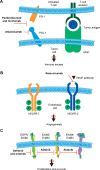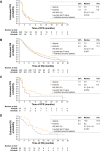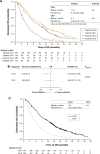Development of treatment options for Chinese patients with advanced squamous cell lung cancer: focus on afatinib
- PMID: 30863118
- PMCID: PMC6390854
- DOI: 10.2147/OTT.S188296
Development of treatment options for Chinese patients with advanced squamous cell lung cancer: focus on afatinib
Abstract
Lung cancer is the leading cause of cancer death in China, and approximately one third of these cancers are squamous cell carcinoma (SqCC) of the lung. Ethnic diversity and country-specific environmental factors can account for interindividual variations in response to and tolerability of anticancer therapies. Although several targeted therapies have recently been approved for patients with relapsed/refractory SqCC of the lung, only afatinib, an irreversible ErbB family blocker, has data of Chinese patients. In the Phase III LUX-Lung 8 trial, afatinib demonstrated a significant clinical benefit vs the reversible first-generation EGFR tyrosine kinase inhibitor erlotinib in both the overall population and the Chinese subset, with a manageable safety profile. Emerging biomarker data from LUX-Lung 8 suggest that patients with ErbB mutations, especially ErbB2, and those classified as "good" in the VeriStrat® proteomic test, may benefit from afatinib treatment in particular, regardless of ethnicity, and may get a long-term response. In conclusion, afatinib is a valid second-line option for Chinese patients with SqCC of the lung, and specific biomarkers may help guide in treatment decision-making. Ongoing studies will provide further guidance on afatinib's place in the treatment algorithm, alongside the other novel targeted therapies.
Keywords: Chinese; EGFR; ErbB; NSCLC; afatinib; biomarker; squamous cell carcinoma.
Conflict of interest statement
Disclosure Medical writing assistance was supported financially by Boehringer Ingelheim. The author reports no other conflicts of interest in this work.
Figures







Similar articles
-
Evaluation of the VeriStrat® serum protein test in patients with advanced squamous cell carcinoma of the lung treated with second-line afatinib or erlotinib in the phase III LUX-Lung 8 study.Lung Cancer. 2017 Jul;109:101-108. doi: 10.1016/j.lungcan.2017.05.010. Epub 2017 May 11. Lung Cancer. 2017. PMID: 28577938 Clinical Trial.
-
Advanced Squamous Cell Carcinoma of the Lung: Current Treatment Approaches and the Role of Afatinib.Onco Targets Ther. 2020 Sep 22;13:9305-9321. doi: 10.2147/OTT.S250446. eCollection 2020. Onco Targets Ther. 2020. PMID: 33061419 Free PMC article. Review.
-
[Afatinib in patients with squamous cell carcinoma of the lung: current context and the option of oral treatment].Med Clin (Barc). 2016 Apr;146 Suppl 1:25-9. doi: 10.1016/S0025-7753(16)30260-3. Med Clin (Barc). 2016. PMID: 27426245 Review. Spanish.
-
Afatinib versus erlotinib as second-line treatment of patients with advanced squamous cell carcinoma of the lung (LUX-Lung 8): an open-label randomised controlled phase 3 trial.Lancet Oncol. 2015 Aug;16(8):897-907. doi: 10.1016/S1470-2045(15)00006-6. Epub 2015 Jul 5. Lancet Oncol. 2015. PMID: 26156651 Clinical Trial.
-
New developments in the treatment of advanced squamous cell lung cancer: focus on afatinib.Onco Targets Ther. 2017 May 11;10:2513-2526. doi: 10.2147/OTT.S104177. eCollection 2017. Onco Targets Ther. 2017. PMID: 28546756 Free PMC article. Review.
Cited by
-
Prognostic Indicators for Precision Treatment of Non-Small Cell Lung Carcinoma.Cells. 2024 Oct 28;13(21):1785. doi: 10.3390/cells13211785. Cells. 2024. PMID: 39513892 Free PMC article. Review.
-
A prognostic model for elderly patients with squamous non-small cell lung cancer: a population-based study.J Transl Med. 2020 Nov 16;18(1):436. doi: 10.1186/s12967-020-02606-3. J Transl Med. 2020. PMID: 33198777 Free PMC article. Clinical Trial.
-
Diagnostic, Predictive, and Prognostic Biomarkers in Non-Small Cell Lung Cancer (NSCLC) Management.J Pers Med. 2021 Oct 27;11(11):1102. doi: 10.3390/jpm11111102. J Pers Med. 2021. PMID: 34834454 Free PMC article. Review.
-
The role of CDK8 gene polymorphisms in bladder cancer susceptibility and prognosis: a study in the Chinese Han population.BMC Cancer. 2025 Apr 16;25(1):714. doi: 10.1186/s12885-025-14132-w. BMC Cancer. 2025. PMID: 40241036 Free PMC article.
References
Publication types
LinkOut - more resources
Full Text Sources
Research Materials
Miscellaneous

